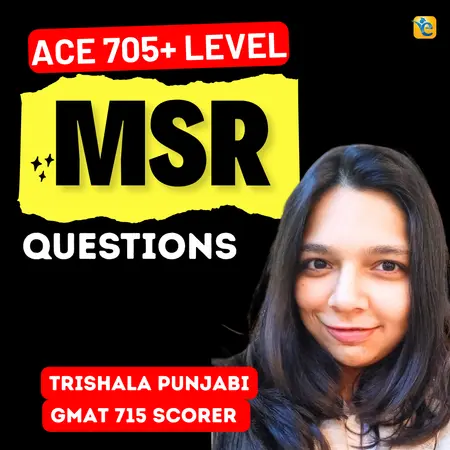Events & Promotions
|
|

GMAT Club Daily Prep
Thank you for using the timer - this advanced tool can estimate your performance and suggest more practice questions. We have subscribed you to Daily Prep Questions via email.
Customized
for You
Track
Your Progress
Practice
Pays
Not interested in getting valuable practice questions and articles delivered to your email? No problem, unsubscribe here.
- Nov 22
11:00 AM IST
-01:00 PM IST
Do RC/MSR passages scare you? e-GMAT is conducting a masterclass to help you learn – Learn effective reading strategies Tackle difficult RC & MSR with confidence Excel in timed test environment - Nov 23
11:00 AM IST
-01:00 PM IST
Attend this free GMAT Algebra Webinar and learn how to master the most challenging Inequalities and Absolute Value problems with ease. - Nov 25
10:00 AM EST
-11:00 AM EST
Prefer video-based learning? The Target Test Prep OnDemand course is a one-of-a-kind video masterclass featuring 400 hours of lecture-style teaching by Scott Woodbury-Stewart, founder of Target Test Prep and one of the most accomplished GMAT instructors.
Kudos
Bookmarks
C
Be sure to select an answer first to save it in the Error Log before revealing the correct answer (OA)!
Difficulty:
 65%
(hard)
65%
(hard)
Question Stats:
61% (02:29) correct 39%
(02:36)
wrong
39%
(02:36)
wrong  based on 149
sessions
based on 149
sessions
History
Date
Time
Result
Not Attempted Yet
A student needs an alarm clock to wake up, which has proven to successfully wake him 80% of the time. If he hears the alarm in the morning the probability of writing the test is 0.9 and if he doesn't hear the alarm the probability is 0.5. If he doesn't write the test, what is the probability that he didn't hear the alarm clock?
A. 5/41
B. 4/9
C. 5/9
D. 36/41
E. 38/41
Are You Up For the Challenge: 700 Level Questions
A. 5/41
B. 4/9
C. 5/9
D. 36/41
E. 38/41
Are You Up For the Challenge: 700 Level Questions
Kudos
Bookmarks
If we imagine 100 mornings, on 80 of them, he hears the alarm, and on 20 of them he does not. When he hears the alarm, 8 times he still doesn't take the test. When he does not hear the alarm, 10 times he doesn't take the test. So of the 18 times when he fails to take the test, on 10 of them he didn't hear the alarm, and the answer is 10/18 = 5/9.
General Discussion
Kudos
Bookmarks
By Bayes Theorem, P(A given B) = P(A/B) = P(A and B) / P(B)
Let the Probability of writing the test = P(W)
To Find: P(Doesn't hear the Alarm given that he doesn't writes the test) = P(A'/W') = P(A' and W') / P(W')
(i) P(W) = P(A) * P(W/A) + P(A') * P(W/A')
(ii) P(A' and W') = 1 - P(A U B) = 1 - [P(A) + P(W) - P(A and W)
Data Given
Probability of hearing the Alarm = P(A) = 0.8
Therefore, Probability of not hearing the Alarm = P(A') = 1 - 0.8 = 0.2
Probability of writing the test given he hears the alarm = P(W/A) = 0.9
Therefore 0.9 = P(W and A) / 0.8
P(W and A) = 0.9 * 0.8 = 0.72
Probability of writing the test given he does not hear the alarm = P(W/A') = 0.5
(i) P(W) = P(A) * P(W/A) + P(A') * P(W/A') = (0.8 * 0.9) + (0.2 * 0.5) = 0.72 + 0.1 = 0.82
Therefore P(W') = 1 - 0.82 = 0.18
(ii) P(A' and W') = 1 - P(A or W) = 1 - [P(A) + P(W) - P(A and W)] = 1 - (0.8 + 0.82 - 0.72) = 0.1
Therefore, P(A'/W') = 0.1 / 0.18 = 10/18 = 5/9
Option C
Arun Kumar
Let the Probability of writing the test = P(W)
To Find: P(Doesn't hear the Alarm given that he doesn't writes the test) = P(A'/W') = P(A' and W') / P(W')
(i) P(W) = P(A) * P(W/A) + P(A') * P(W/A')
(ii) P(A' and W') = 1 - P(A U B) = 1 - [P(A) + P(W) - P(A and W)
Data Given
Probability of hearing the Alarm = P(A) = 0.8
Therefore, Probability of not hearing the Alarm = P(A') = 1 - 0.8 = 0.2
Probability of writing the test given he hears the alarm = P(W/A) = 0.9
Therefore 0.9 = P(W and A) / 0.8
P(W and A) = 0.9 * 0.8 = 0.72
Probability of writing the test given he does not hear the alarm = P(W/A') = 0.5
(i) P(W) = P(A) * P(W/A) + P(A') * P(W/A') = (0.8 * 0.9) + (0.2 * 0.5) = 0.72 + 0.1 = 0.82
Therefore P(W') = 1 - 0.82 = 0.18
(ii) P(A' and W') = 1 - P(A or W) = 1 - [P(A) + P(W) - P(A and W)] = 1 - (0.8 + 0.82 - 0.72) = 0.1
Therefore, P(A'/W') = 0.1 / 0.18 = 10/18 = 5/9
Option C
Arun Kumar











